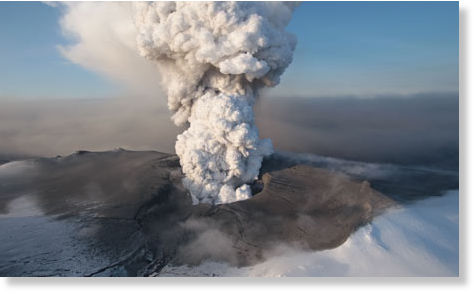
© JON GUSTAFSSON/APIceland's Eyjafjallajokull volcano
A team of
University of Southampton geologists say they have uncovered the "trigger" mechanism that seems to unleash some of Earth's most massive volcano, including the massive volcanic eruption of Eyjafjallajokull in Iceland in 2010, which left millions of passengers stranded around the world.
Working in the Canary Islands, the Southampton team examined the causes of trapped magma to see what caused eruptions at the Las Cañadas volcanic caldera on Tenerife, located on one of the Canary Islands. The volcano has generated at least eight major eruptions during the last 700,000 years, according to the team.
By analyzing crystal cumulate nodules (igneous rocks formed by the accumulation of crystals in magma) discovered in pyroclastic deposits of major eruptions, the scientists found that pre-eruptive mixing within the magma chamber - where older cooler magma mixed with younger hotter magma - appears to be the repeating trigger in large-scale eruptions, according to researchers. These nodules trapped and preserved the final magma beneath the volcano immediately before eruption, providing geologists with a potential signature for Earth's most destructive volcanoes.
"These nodules are special because they were ripped from the magma chamber before becoming completely solid - they were mushy, like balls of coarse wet sand," researcher Rex Taylor, Senior Lecturer in
Ocean and Earth Science at the University of Southampton, said in a statement. "Rims of crystals in the nodules grew from a very different magma, indicating a major mixing event occurred immediately before eruption."
The team said the analysis provided a never-before-seen process that researchers say likely is the last final process and change before a massive volcanic eruption takes place.
"The analysis of crystal nodules from the volcano documents the final processes and changes immediately prior to eruption - those triggering the catastrophic eruptions. The very presence of mushy nodules in the pyroclastic deposits suggests that the magma chamber empties itself during the eruption, and the chamber then collapses in on itself forming the caldera," says co-author of the study, Dr Tom Gernon, Lecturer in Ocean and Earth Science at the University of Southampton.
The study comes just weeks before the busiest season for air travel. In 2010, a massive volcanic eruption in Iceland caused airlines to cancel thousands of international fights, grounding passengers on both sides of the Atlantic for nearly two weeks. Experts said the volcano emitted a massive amount of ash, which can clog jet engines. It is estimated that the eruption cost airlines nearly $200 million per day and totaled well over $4 billion. Better forecasting of volcanoes could allow scientists to issue warnings to airlines, allowing for reroutes and advanced delays.
It remains unclear whether the "trigger" can be applied to predict eruptions of smaller volcanoes. Still, the discovery will likely face a number of tests in the coming years. Already geologists are predicting that one of Iceland's largest glaciers could be the site of a looming volcanic eruption that could be one of the most powerful the country has seen in almost a century. Mount Katla, one of Iceland's largest volcanoes, has the potential to cause catastrophic flooding, that could send billions of gallons of water surging through Iceland's east coast and tons of ash into the jet stream.
Reader Comments
to our Newsletter